
Spooky Places on Campus
InfoLink - Sun Oct 27, 2013
Have you ever heard a bump in the night while studying late on campus? Have you ever sworn that there were more than just students wondering your residence floor after midnight? Well, you aren’t the only one…
During the summer Edmonton Ghost Tours was conducting tours on, well, you guessed it, the University of Alberta campus. These tours began at the Rutherford House on Saskatchewan drive, and then wove through campus before stopping at Emily Murphy’s House in East Campus Village (ECV). Seeing as it is many students first time on campus, I thought it might be neat to share some of the ghostly and historic stories that I learned while on this tour. So here we go…
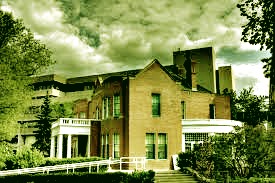 Photo courtesy of Wikipedia
Photo courtesy of Wikipedia
Imagine it’s sunset, about 9:00 p.m., and you’re standing in front of the Rutherford House. A woman walks to the top of the cement staircase and informs you it’s time to begin the ghost tour of the University’s campus.
Rutherford House, a modern provincial historic site, was the home of Alberta’s first premier, Alexander Rutherford, and his family. In 1911 the building project was completed, but it was still surrounded by a substantial amount of open land. This land was later bought from Mr. Rutherford to be the home of the University of Alberta campus. At this point you may ask why this is such a ghostly matter… well, apparently, according to the individuals who work in the restaurant downstairs, there is a little boy—dressed in 1920’s attire—who stands by the upstairs office and bounces a little blue ball. No one knows who this boy is, or where he came from, but they do know that he is there one minute and gone the next.
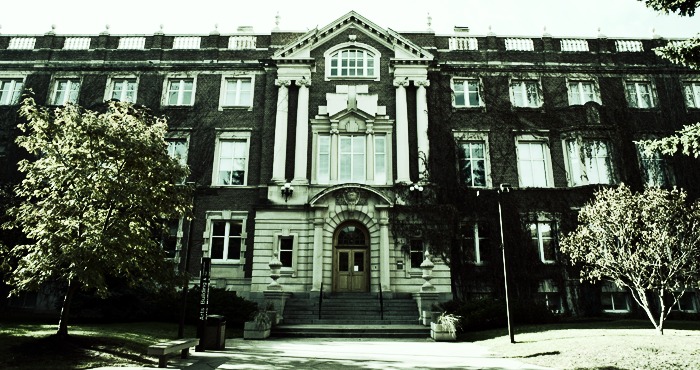 Photo courtesy of the Faculty of Arts on Flickr
Photo courtesy of the Faculty of Arts on Flickr
After the Rutherford House we made our way down to the Old Arts Building. Built in in 1912, the Old Arts Building is the second oldest building on campus. During both the First and Second World Wars, the building was used as an information center, where individuals worked to coordinate the war efforts. It is said that during the construction of this building two of the Irish workers contracted for the project fell in love with the same woman: they fought before work, the fought after work, and yup, you guessed it, they even fought during work! Then one day the two of them were working on the roof together, the side that now faces the Business Building, when a fight broke out! There was lots of pushing, and screaming, and yelling, and then BAM! Just like that one of the men had pushed his interlocutor off the roof to his painful death on the pavement below. Following this ordeal the young woman packed her bags and headed back to Ireland, and the living man didn’t get the girl after all (Shocker!). Today, students regularly see the shadowy figures of these two men duking it out on the roof of the Old Arts Building.
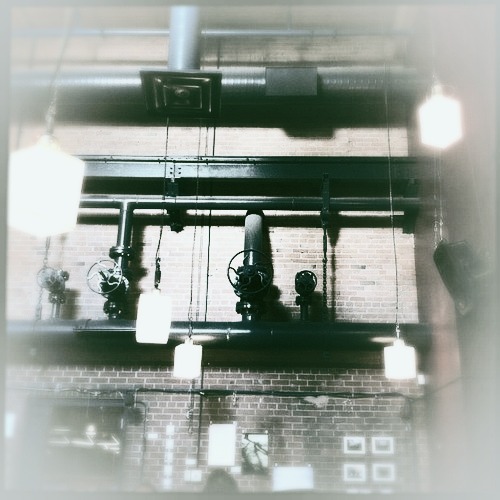 Photo courtesy of The University of Alberta on Tumblr
Photo courtesy of The University of Alberta on Tumblr
Following around the South side of the Old Arts Building, the group congregated again in front of our beloved Dewey’s, also known as the Old Power Plant. From opening, until the 1940’s, this building used to burn all of the campus garbage, filling the university campus with a thick black smog and what I imagine would have been a terrible smell, as they burned everything from science experiments to food waste. However, it is the modern hauntings that make this building so spooky. According to our tour guide, who interviewed the staff members at Dewey’s, some of the things in the bar will move around without explanation. For example, when the staff members push all of the tables and chairs to the outside of the room to mop the floors at the end of the night, they will turn around and all of the furniture will be re-arranged as it appears during the day… also, it has been reported, that when the bar tender leaves beer on the counter it will be moved by some unexplainable force.
The final story of this building revolves around a scientist that used to work in the building. Before the building was used as a campus pub it housed the Faculty of Science, including one scientist who had been recruited from McGill University to work on a project related to the Alberta Oil Sands. This scientist used to work in a basement laboratory with no windows and no assistants; he wore a pair of wiry glasses high up on the bridge of his nose, and a lab coat that was stained with the remnants of his previous experiments. Creating a revolutionary system used to separate the oil from the sand and other particulates in the soil, he was able to create a system that would be responsible for a lot of Alberta’s wealth in future years. Unfortunately the elderly scientist didn’t live to see his project applied in the Oil Sands, so it is said that sometimes bit of unrefined oil will be found in the drains of the Old Power Plant and sometimes there will even be an apparition of the scientist walking the hallway.
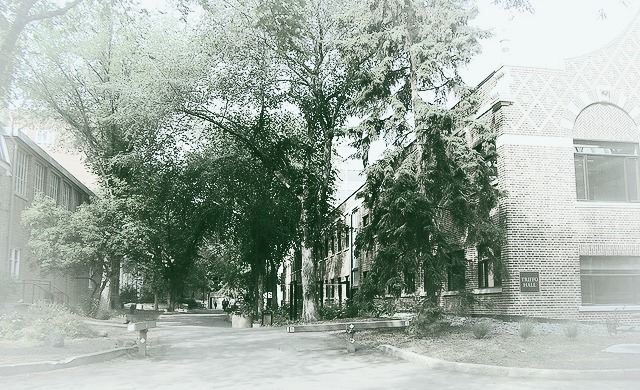 Photo courtesy of mjthomas43 on Flickr
Photo courtesy of mjthomas43 on Flickr
Standing at that junction between Triffo Hall and the Old Power Plant our tour guide told us about the different kinds of bricks that were used to construct the buildings in the area. Historically a kind of brick called a Clinker Brick was used to construct buildings for cheaper than what it would cost to build the building using normal bricks. Clinker Bricks were cheaper than regular bricks because they are darker and were regarded as something that wasn’t as “nice.” The dark colour that made the bricks “ugly” was created when the bricks were fired; when fired the bricks closest to the inside would be burnt darker than those on the outside, which would be the lighter brick colour. If you look at many of the buildings around campus you’ll see that many of the buildings were constructed using these bricks. In the twenty-first century any building constructed using these bricks is designated as an Alberta Historic Site.
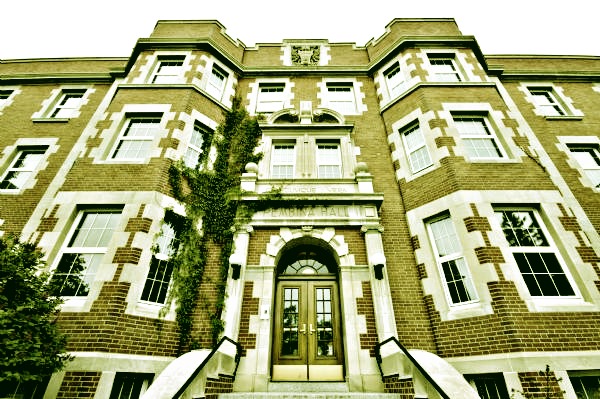 Photo courtesy of Scorpio Masonry
Photo courtesy of Scorpio Masonry
Continuing our tour we walked underneath the CAB pedway, across Quad, and to the front of Pembina Hall. Of all of the stories we heard that night the ones related to Pembina Hall were the scariest, in my opinion. During the 1918 Flu Pandemic that swept the City of Edmonton the University turned Pembina Hall into a makeshift hospital. Many individuals died in Pembina Hall as a result of the disease. During 1918 the individuals running the building decided that they should store the deceased bodies in the building’s basement, to protect the patients from the Spanish Flu (or so they thought); however, storing the bodies in the hot basement during the Edmonton summer wasn’t a good idea, because it increased the speed at which the bodies decomposed inside the building. Due to this decision it is said that sometimes, on a hot summer day, the smell of the decomposing bodies can be smelled throughout the building.
The second story involves a couple that met while attending the University of Alberta. When it was first built Pembina Hall was used as a residence building, where the upper floor was used for professors, the third floor for students, and the bottom two floors were used for teaching. Well, the couple met while living in Pembina Residence and they fell in love. Soon, unfortunately, the couple had to be separated due to the events of the Second World War: the woman stayed in Edmonton to volunteer as a nurse and the male went to join the army. Working in Pembina Hall the woman found her friend who had been injured in the war. She stayed by his bed doing her best to nurse him back to health, but it just wasn’t enough. He died soon after arriving in Pembina and the next morning, it is said, the woman ran down to the river valley and committed suicide by throwing herself in, but her body was never found. To this day a ghostly pair, a female with a nurse’s uniform and a man wearing an army uniform, can be seen wondering the halls of Pembina.
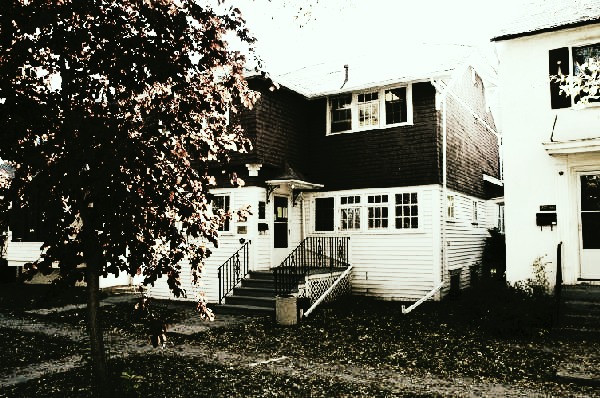 Photo courtesy of Real Estate Weekly
Photo courtesy of Real Estate Weekly
The final stop on our tour was Emily Murphy’s House in EVC, where Student Legal Services currently resides. It is said that Emily Murphy, a member of the Famous Five, haunts the house (well, I like to think of it as a “friendly” haunt) from her upstairs bedroom. Looking at the house you’ll notice that there is a left bedroom window. It was in this bedroom that Murphy died in 1933, but today her face is reported to appear in the window to watch all of the women on the U of A campus getting an education!
See, that’s not scary!
